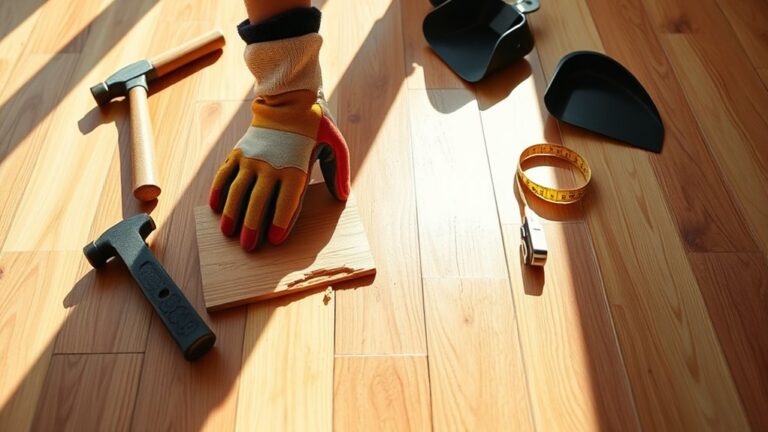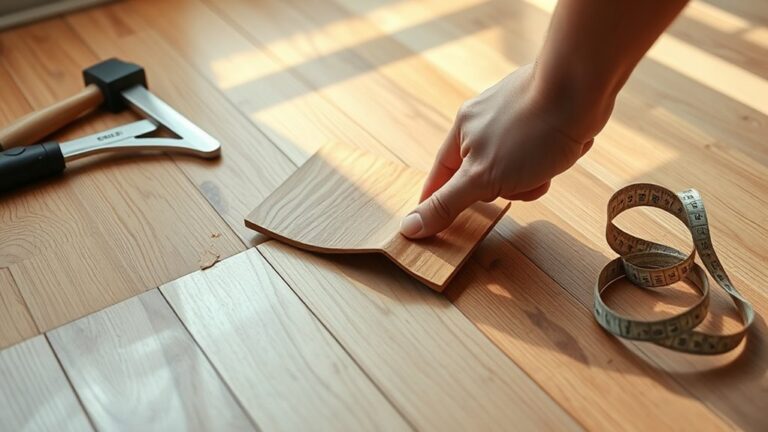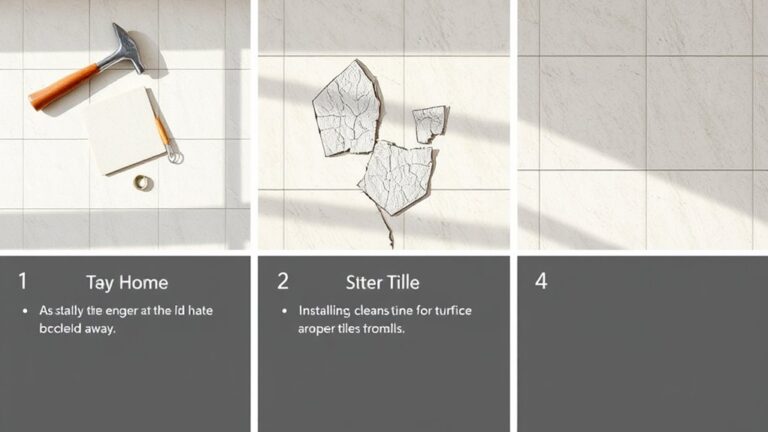To remove old black urine stains from hardwood floors, first identify and assess the stained area to understand its extent. Next, prepare a gentle cleaning solution like equal parts white vinegar and water or mild soap diluted in water. Apply it carefully with a soft cloth, scrubbing gently to avoid damage. Rinse thoroughly and dry the floor immediately to prevent residue. Finally, restore the finish with light sanding, staining, and sealing to protect your floors. Keep going to discover detailed tips for each step.
Identify and Assess the Stained Area

Before you begin any cleaning, you need to carefully identify and assess the stained area on your hardwood floor. Accurate stain identification is essential because it determines the cleaning approach and protects your floor from damage. Examine the discoloration closely—urine stains often appear dark and may have a distinct odor. Conduct a thorough floor assessment by checking the extent of the stain, its depth, and any surrounding damage such as warping or discoloration. Use a flashlight to verify you don’t miss subtle spots. This precise evaluation empowers you to address the issue effectively, guaranteeing your hardwood floor regains its natural beauty without unnecessary treatments. Taking these initial steps confidently sets the foundation for successful stain removal and floor restoration.
Prepare the Cleaning Solution
Once you’ve thoroughly assessed the stained area, you’re ready to prepare the cleaning solution that will effectively tackle the urine stain without harming your hardwood floor. Start by selecting gentle cleaning products designed for hardwood surfaces, avoiding harsh chemicals that could damage the finish. A reliable mixture includes equal parts white vinegar and water, which works well for stain removal due to its natural deodorizing and disinfecting properties. Alternatively, a mild dish soap diluted in water can also be effective. Be certain to test your chosen solution on a small, inconspicuous spot to confirm it won’t discolor or damage the wood. Preparing the right cleaning solution is vital—it guarantees you remove the stain efficiently while preserving your floor’s integrity and freedom to enjoy a clean, natural space.
Apply the Solution and Scrub Gently

Apply the cleaning solution directly onto the urine stain using a soft cloth or sponge, ensuring the area is thoroughly saturated but not soaked. Use gentle scrubbing techniques to avoid damaging your hardwood floor’s finish. Employ circular motions with light pressure, gradually loosening the stain without grinding it deeper into the wood. Select cleaning tools designed for delicate surfaces—avoid abrasive brushes or harsh scrubbers that can scratch or dull the floor. If needed, switch to a soft-bristle brush for stubborn spots, but keep the pressure minimal. Remember, patience is key; aggressive scrubbing can cause more harm than good. By carefully applying the solution and scrubbing gently, you maintain your floor’s integrity while effectively lifting the old black urine stain.
Rinse and Dry the Floor Thoroughly
After scrubbing the stain, you’ll want to rinse the area thoroughly to remove any remaining cleaning solution. Use a damp cloth or mop with clean water, ensuring no residue lingers that could attract dirt or damage the wood. Proper rinsing is essential for stain prevention and maintaining the floor’s integrity. Once rinsed, dry the floor immediately with a clean, dry towel or microfiber cloth to prevent moisture absorption.
| Cleaning Tools | Purpose | Tips |
|---|---|---|
| Damp Cloth | Remove residue | Wring thoroughly |
| Mop | Cover larger areas | Use clean water only |
| Dry Towel | Absorb moisture | Pat, don’t rub |
| Microfiber Cloth | Final drying | Prevents scratches |
Thorough rinsing and drying free you from lingering stains and preserve your hardwood’s beauty.
Restore and Protect the Hardwood Finish

Although you’ve removed the stain and dried the area thoroughly, your hardwood floor may still need attention to restore its original luster and protect it from future damage. Start wood finish restoration by lightly sanding the affected area with fine-grit sandpaper to smooth any roughness and prepare the surface. Next, apply a matching wood stain if the color has faded. Once dry, seal the area with a high-quality protective coating such as polyurethane or a water-based finish. This layer safeguards your floor against moisture, wear, and potential future stains. By carefully restoring and protecting your hardwood finish, you guarantee its durability and maintain the freedom to enjoy a beautiful, stain-free space without worrying about recurring damage.




